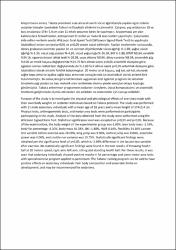Sedanterlere Tabata Protokolü ile Uygulanan Antrenman Programının Bazı Fiziksel, Fizyolojik Parametrelere Etkisi
Özet
Araştırmanın amacı, Tabata protokolü esas alınarak kendi vücut ağırlıklarıyla yapılan egzersizlerin sedanter bireyler üzerindeki fiziksel ve fizyolojik etkilerini incelemektir. Çalışma, yaş ortalaması 18 ve boy ortalaması 174± 5,4 cm olan 11 erkek sedanter birey ile yapılmıştır. Araştırmada yer alan katılımcılara fiziksel testler, antropometrik testler ve motorik alan testleri yapılmıştır. Çalışmadan elde edilen verilerin analizi Wilcoxon Sıralı İşaret Testi (Wilcoxon Signed Rank Test) ile yapılmıştır. İstatistiksel anlam seviyesi p<0,01 ve p<0,05 olarak kabul edilmiştir. Yapılan incelemeler sonucunda, deney grubunun üzerinde yapılan ön ve son test ölçümlerinde vücut ağırlığı %-1.89, yağsız vücut ağırlığı %-1.33, vücut yağ yüzdesi %-4,20, vücut yoğunluğu %-16.38, BKİ %-1.88, HWR %0.64, esneklik %34.16, egzersiz öncesi laktat testi %-28.08, uzun atlama %9.96, dikey sıçrama %8.04, anaerobik güç %4.06 ve mekik koşusu değişkeninde %15.75 fark olmak üzere p<0,01 anlamlılık düzeyine göre; egzersiz sonrası laktat testi değişkeninde de %-2.69 fark olmak üzere p<0,05 anlamlılık düzeyine göre istatistiksel olarak anlamlı farklılık bulunmuştur. 20 metre sürat koşusu, sağ kol, sol kol, oturarak sağlık topu atma ve ayakta sağlık topu atma test sonuçlarında ise istatistiksel olarak anlamlı fark bulunmamıştır. Bu sonuçlara göre katılımcılara uygulanan özel egzersiz programı ile sedanter bireylerin yağ yüzdesi ve bazı motorik alan testlerinde olumlu yönde sonuçlar ortaya koyduğu görülmüştür. Tabata antrenman programının sedanter bireylerin, vücut kompozisyonu ve anaerobik limitlerini geliştirmede olumlu etkisinden söz edilebilir ve sedanterler için tavsiye edilebilir. Purpose of the study is to investigate the physical and physiological effects of exercises made with their own body weights on sedanter individuals based on Tabata protocol. The study was performed with 11 male sedentary individuals with a mean age of 18 years and a mean height of 174±5,4 cm. Physical tests, anthropometric tests, and motor area tests were performed on participants participating in the study. Analysis of the data obtained from the study were performed using the Wilcoxon Signed Rank Test. Statistical significance level was accepted as p<0,01 and p<0,05. Because of the examinations, the body weight of the experimental group was-1.89%, lean body mass -1.33%, body fat percentage -4.20%, body mass 16.38%, BKI -1.88%, HWR 0.64%, flexibility 34.16% Lactate test variable before exercise was-28.08%, long jump was 9.96%, vertical jump was 8.04%, anaerobic power was 4.06%, and shuttle run variance was 15.75%. Statistically significant findings were obtained per the significance level of p<0.05, which is -2.69% difference in the lactate test variable after exercise. No statistically significant findings were found in the test results of throwing health ball at 20 meters speed, right arm, left arm, sitting and standing health ball. Per these results, it was seen that sedentary individuals showed positive results in fat percentage and some motor area tests with special exercise program applied to participant. The Tabata training program can be said to have positive effects on sedentary individuals their body composition and anaerobic limits on development, and may be recommended for sedanters.
Bağlantı
https://hdl.handle.net/11363/344Koleksiyonlar
- Yüksek Lisans Tezleri [164]

















